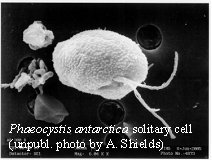Environmental and Ecological Regulation of Differences and Interactions between Solitary and Colonial forms of Phaeocystis antarctica
|
|
PIs: Dr. Kam W. Tang
(kamtang@vims.edu) and Project nickname: ESCAP - Ecology of Solitary and Colonial Antarctic Phaeocystis Funding: NSF-OPP Research site: McMurdo Station, Antarctica Deployment dates:
|
 |
ESCAP Team Members: |
Research Objectives:
Phaeocystis antarctica (Prymnesiophyceae) is widely distributed in the Southern Ocean and plays important roles in polar ecology and biogeochemistry. It is a dominant primary producer, a main component of organic matter vertical fluxes, and the principal producer of volatile organic sulfur in the region. Yet P. antarctica is also one of the lesser known species in terms of its physiology, life history and trophic relationships with other organisms. P. antarctica occurs mainly in two morphotypes: solitary cells and mucilaginous colonies, which differ significantly in size, architecture and chemical composition. Relative dominance between solitary cells and colonies determines not only the size spectrum of the population, but also its carbon dynamics, nutrient uptake and utilization. However, what regulates the differences between solitary and colonial forms of P. antarctica is not certain. The research objective of this project was to address these over-arching questions:
- Do P. antarctica solitary cells and colonies differ in growth, composition and photosynthetic rates?
- How do nutrients and grazers affect colony development and size distribution of P. antarctica?
- How do nutrients and grazers act synergistically to affect the long-term population dynamics of P. antarctica?
Experiments were conducted in the McMurdo station with natural P. antarctica assemblages and co-occurring grazers. Laboratory experiments were conducted to study size-specific growth and photosynthetic rates of P. antarctica, size-specific grazing mortality due to microzooplankton and mesozooplankton, the effects of macronutrients and micronutrients on the relative dominance of solitary cells and colonies, and the effects of grazing-related chemical signals on P. antarctica colony development. We also developed educational materials to bring polar science to K-12 students and the general public.
Peer-reviewed Publications (please contact us for reprints):
Elliott DT, Tang KW, Shields AR (2008) Mesozooplankton beneath the summer sea ice in McMurdo Sound, Antarctica: abundance, species composition, and DMSP content. Polar Biology 32:133-122
Tang KW, Smith WO Jr, Elliott DT, Shields AR (2008) Colony size of Phaeocystis antarctica (Prymnesiophyceae) as influenced by zooplankton grazers. Journal of Phycology 44:1372-1378
Shields AR, Smith WO Jr (2008) An examination of the role of colonial Phaeocystis antarctica in the microbial food web of the Ross Sea. Polar Biology 31:1091-1099
Conference and invited presentations:
Tang KW, Smith WO Jr, Elliott DT, Shields AR (2008) It's good to be big--- Phaeocystis antarctica colony size under the influence of zooplankton grazers. Ocean Sciences Meeting, Orlando.
Tang KW (2008) Ecology of solitary and colonial Phaeocystis antarctica. IGB-Neuglobsow, Germany.
Tang KW, Shields AR, Smith WO Jr. (2007) Dark and cold survival of Phaeocystis antarctica. Workshops on Phaeocystis blooms: causes and consequences, France. [Abstract] [Powerpoint presentation] (Data are not to be cited without permission from the authors)
Nejstgaard JC, Artigas LF, Antajan E, Sazhin AF, Tang KW, Steinke M, Dutz J, Koski M, Long JD, Guiselin N (2007) Zooplankton grazing on Phaeocystis: a quantitative review and results from bottle incubation experiments and molecular gut analysis in the eastern English Channel. Workshop on Phaeocystis blooms: causes and consequences, France.
Tang KW (2007) Why its sucks to be single--- a lesson from the enigmatic haptophyte Phaeocystis. Crary Science Lecture, McMurdo Station, Antarctica.
Tang KW (2006) Ecology of solitary and colonial forms of Phaeocystis (invited seminar). Polar Research Institute of China, China.
Tang KW (2006) Ecology of solitary and colonial forms of Phaeocystis (invited seminar). South China Normal University and Jinan University (joint seminar), China.
Tang KW (2006) Ecology of solitary and colonial forms of Phaeocystis (invited seminar). HK University of Science and Technology, Hong Kong.
Outreach Activities:
Invited talk: “ESCAP in McMurdo: studying a unique phytoplankton species in Antarctica”, Mentoring Young Scientists program, Virginia Aquarium and Marine Science Center (November 2008)
“ESCAP from McMurdo: studying a unique phytoplankton species in Antarctica” Hampton University DREAMS seminar (October 2008)
Invited talk: “Into the Cold--- a scientific journey” (presented to Marine Science Club), Booker T. Washington Middle School, Newport News, Virginia (November 2007)
Invited talk: “Into the Cold--- a scientific journey” (presented to 7th graders), Booker T. Washington Middle School, Newport News, Virginia (November 2007)
Invited talk: “Into the Cold--- a scientific journey” (presented to 7th graders), VIMS REU program (June 2007)
“Into the Cold--- a scientific journey”, Hampton University DREAMS seminar (February 2006)
Bringing polar science to K-12 classroom:
In 2006/7 season we invited Jennifer Gaydos (William & Mary School of Education) to join the ESCAP team. Jennifer was a teacher-in-training in Lafayette High School (Williamsburg, VA). In addition to actively participating in the experiments, Jennifer established a web diary for her LHS students to follow our research activities in McMurdo. We also did a live web-cast to directly communicate with Lafayette students and talked to them about living and working in McMurdo.
Upon return, Jennifer produced a digital “documentary” of the ESCAP project based on her own experience. This documentary has become a great tool for our outreach effort. We also have a collection of photos and powerpoint presentations suitable for educational use. If you would like to receive a copy of the documentary or other educational materials related to our project, or to invite us to talk to K-12 students about polar research, please contact Kam Tang.

